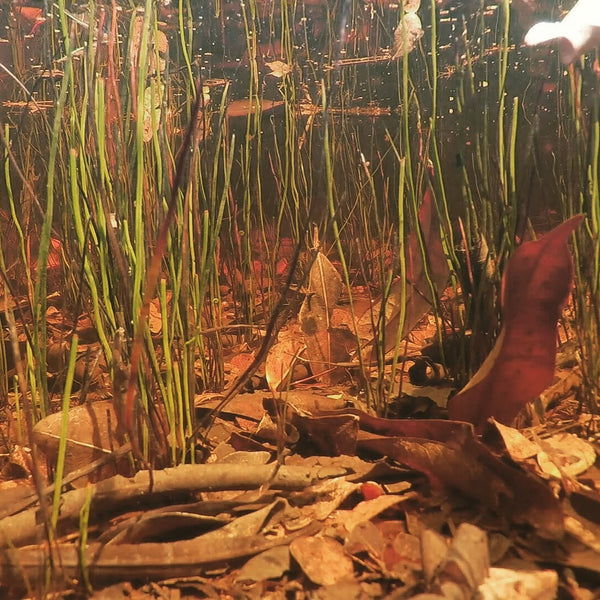- Continue Shopping
- Your Cart is Empty
Evolution. Inspiration. Simplicity. Tint.
You know what is really gratifying?
To hear from fellow fish geeks that something you do has inspired an influences them in their own aquarium work! Interestingly, my little "P. simulans Igapo nano aquarium that I set up in the office, even in its most early phases, has garnered a lot of attention and interesting from people in our community. We're trying to update "real time" as we go.
We've already talked about how this tank was beautiful pivot from an original idea...a little killifish biotope. As discussed previously, I immediately went to "Plan B" and this obscenely simple aquarium is becoming one of my fave tanks ever! Weird! Judging by the number of PM's and emails I'm receiving about it, I think it has struck a chord in a number of you!
First off, everyone seems to want to know the botanical selections.
They could not be more simple: 2 packs of Texas Live Oak Leaves, 1 pack Malaysian Yellow Mangrove Leaves, and 1 "Twenty Twigs" pack. The wood is three small pieces of Spider Wood. The substrate is a 1/4" /.635cm layer of CaribSea "Sunset Gold" sand. (my "go-to" substrate for my BWBS tanks). It really nicely represents the podzol soils common to this region of the world.
This simple combination of materials has really created a realistic-looking representation of the igapo with very little effort. What's nice about the leaves that I've incorporated into this setup is that they are two of the longer-lasting leaves we work with, meaning that they'll "hold form" for a good length of time. Oh, and they're "to scale" with the small size of the tank.
And the oak twigs are really perfect for what we're doing here. Remember, and igapo is literally a terrestrial forest floor that is seasonally inundated by water. What you'd find on the forest floor (like, leaves, twigs, tree part, etc.) is exactly what we're using here.
A quick note on the "Spider Wood"- I believe this well-known aquarium wood to be Azalea root.
After prolonged submergence, it looses the orangeish color and smooth texture and becomes much darker and more roughly textured, much to my delight! I experienced this nice transformation in my home blackwater aquarium, which uses this wood as the exclusive hardscape in the tank.
The only downside to this wood is that it is among the most "fungus and biofilm-inducing" wood types you'll ever see, recruiting significant amounts of the gooey stuff during it's early submersion phases! You just have to stay on the removal process and it will pass after a few weeks!
One of the latest obsession I have with flooded Amazonian forest floors is to find out the plants which are commonly found there and survive and even grow during the period of inundation.
One of my goals is to find either the seeds or some sprouting versions of some of these plants. It's not easy, although I might of found a few sources for seeds of one of the fruit-bearing plants of the region, Jaboticaba, Myrciaria sp.. In one study I found about the plants which grow in the inundated igapo habitats, the most common species are Eugenia inundata, Sphinctanthus stmflorus and Securidaca longifoliaare. These are found most frequently in the water during the inundation.

Now, obviously, many of these are (in no particular order) too large, too slow to grow, and too damn hard to find... It might be a matter of finding substitutes of plants which function as facsimiles. Sure, we've all played with Philodendron and such, which root in water without substrate, and many hobbyists incorporate them into their aquariums.
Cool, but not the real affect I'm looking for. I'm trying to achieve the look of plants growing out of the soil, partially submerged, as opposed to a plant simply rooting in water. Make sense?
See the palm in the igapo pic by Mike Tuccinardi above? I don't know the species. However, I have sort of similar-appearing potted "Cat Palm", Chamaeodorea cataractarum in our home, which I've taken cuttings from at various time for this type of experimentation. t's from Mexico and never is found as far south as Brazil, but it kinda looks the part!
It throws of little plants now and again, and seems to have even rooted in water without substrate in tests I've done. Palms don't typically root in water- they need substrate, so this was truly an anomaly. Oh, and they don't root from "cuttings"- you need to actually utilize either a small specimen that already has established some roots. So, of course, I had to include the little "water-rooted" cutting that I had going...let's see if it survives, let alone grows!
The other plants, along with some grasses which have North American analogs, are fascinating, and are ones I'll have to source at some point.
My goal has been to use this tank as a sort of "test bed" for what I hope to do o na much larger scale in the future. It will be fun to try some different plants to see what gives me the look and function I'm trying to achieve! I think one of the first issues will be to simply provide a deeper substrate! I can't do this in the tiny ADA 60F I'm using, but in a larger aquarium, it will be easy to do!
We'll be continuing to document the evolution of this simple, yet remarkably engaging little tank. My fondest wish is that it not only provides a few ideas and answers for me, but that it inspires and motivates YOU to try some similar experiments, which will make a huge impact on our community!
Stay excited. Stay engaged. Stay bold. Stay creative.
And Stay Wet.
Scott Fellman
Tannin Aquatics














Scott Fellman
Author